各位老师好,我使用pimpleDyMFoam计算钝体涡激振动时,算例的CFL越来越大并计算一段时间后发散。通过查看速度和压力场,发现一开始就不太正常,然后随着时间推移,误差逐渐积累最后发散。报错如下:
#0 Foam::error::printStack(Foam::Ostream&) at ??:?
#1 Foam::sigFpe::sigHandler(int) at ??:?
#2 ? in "/lib/x86_64-linux-gnu/libc.so.6"
#3 Foam::GAMGSolver::scale(Foam::Field<double>&, Foam::Field<double>&, Foam::lduMatrix const&, Foam::FieldField<Foam::Field, double> const&, Foam::UPtrList<Foam::lduInterfaceField const> const&, Foam::Field<double> const&, unsigned char) const at ??:?
#4 Foam::GAMGSolver::Vcycle(Foam::PtrList<Foam::lduMatrix::smoother> const&, Foam::Field<double>&, Foam::Field<double> const&, Foam::Field<double>&, Foam::Field<double>&, Foam::Field<double>&, Foam::Field<double>&, Foam::Field<double>&, Foam::PtrList<Foam::Field<double> >&, Foam::PtrList<Foam::Field<double> >&, unsigned char) const at ??:?
#5 Foam::GAMGSolver::solve(Foam::Field<double>&, Foam::Field<double> const&, unsigned char) const at ??:?
#6 Foam::fvMatrix<double>::solveSegregated(Foam::dictionary const&) at ??:?
#7 Foam::fvMatrix<double>::solve(Foam::dictionary const&) in "/home/ying/OpenFOAM41/OpenFOAM-4.1/platforms/linux64GccDPInt32Opt/bin/pimpleDyMFoam"
#8 ? in "/home/ying/OpenFOAM41/OpenFOAM-4.1/platforms/linux64GccDPInt32Opt/bin/pimpleDyMFoam"
#9 __libc_start_main in "/lib/x86_64-linux-gnu/libc.so.6"
#10 ? in "/home/ying/OpenFOAM41/OpenFOAM-4.1/platforms/linux64GccDPInt32Opt/bin/pimpleDyMFoam"
Floating point exception (core dumped)
我查了一下有人说很可能是网格或边界条件的问题。我的边界条件是比较基础的速度入口/压力出口,感觉应该没问题;我也使用了refine的网格重新计算,发现crash的时间延长了,但速度场和压力场还是一开始就不正确。两种网格质量都没问题。
我附加了我的算例设置文件,和流场图以供参考。
-
粗网格及流场
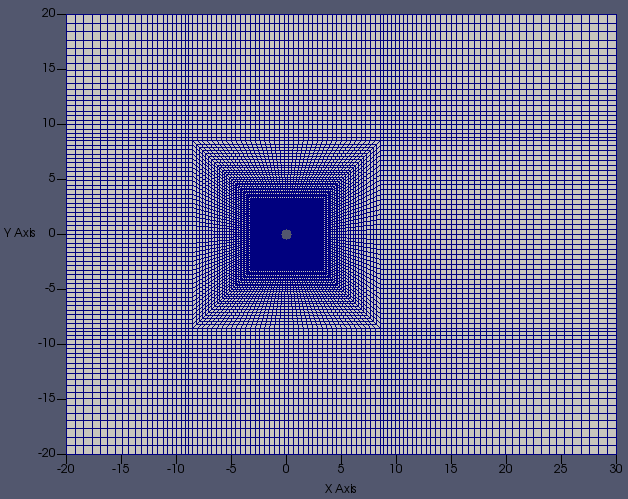
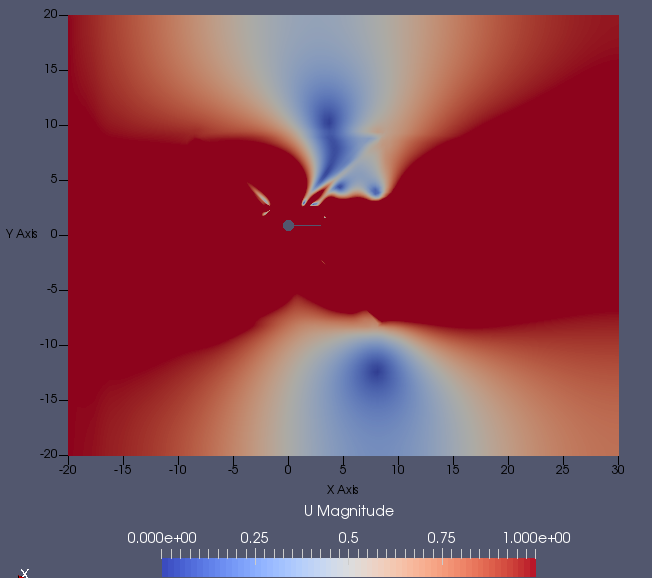
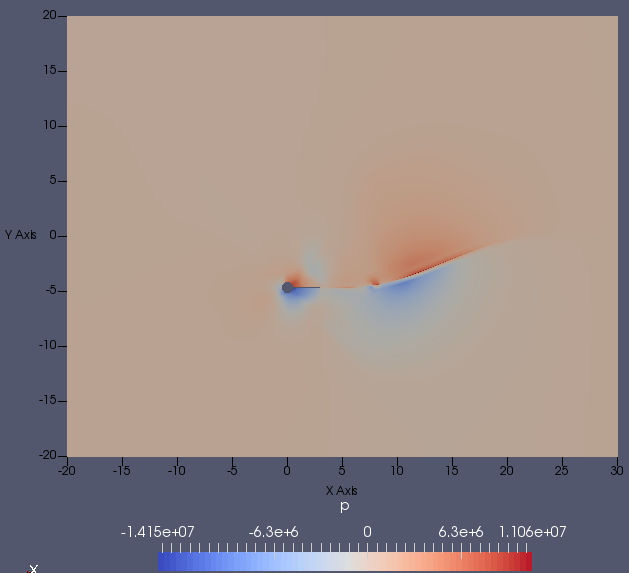
-
细网格及流场
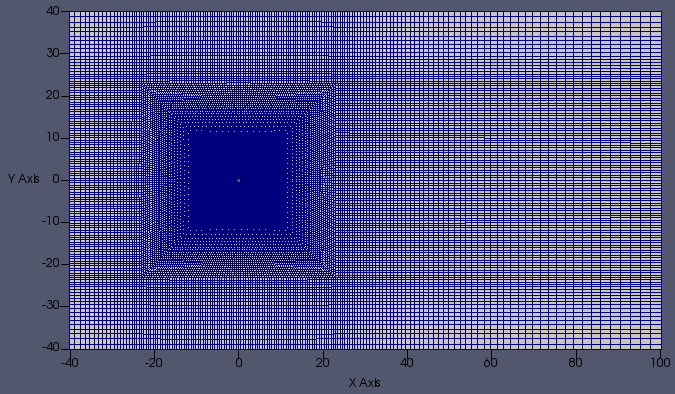
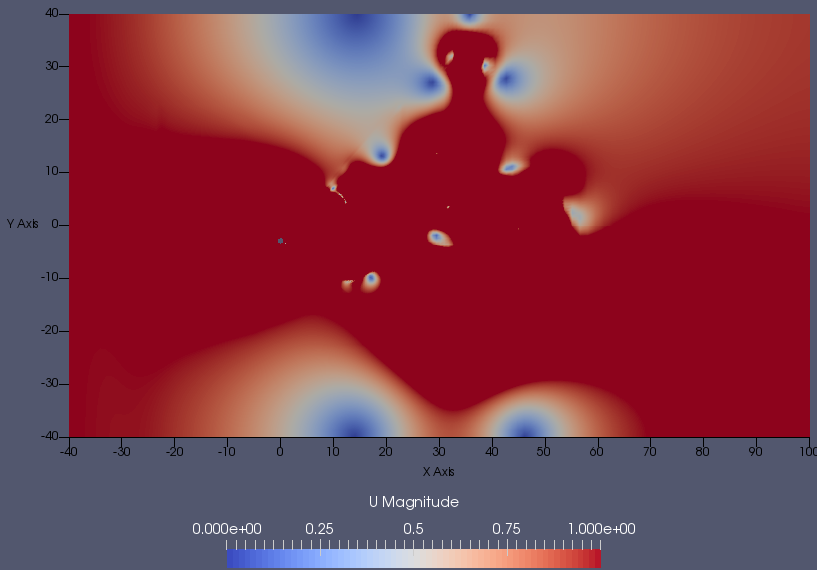
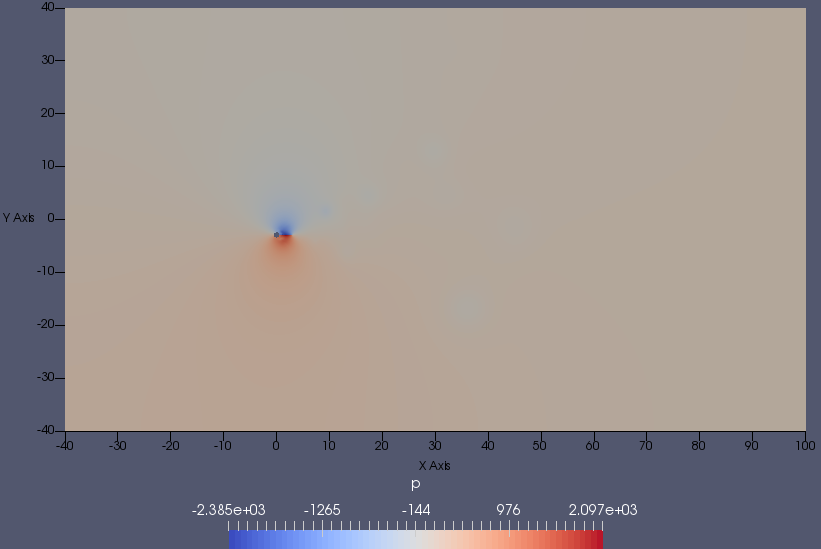
-
边界条件(U/p/pointDisplacement)
FoamFile
{
version 2.0;
format ascii;
class volVectorField;
location "0";
object U;
}
// * * * * * * * * * * * * * * * * * * * * * * * * * * * * * * * * * * * * * //
dimensions [0 1 -1 0 0 0 0];
internalField uniform (0 0 0);
boundaryField
{
INLET
{
type fixedValue;
value uniform (1 0 0);
}
OUTLET
{
type zeroGradient;
}
TOP
{
type symmetry;
}
BOTTOM
{
type symmetry;
}
CYLINDER
{
type movingWallVelocity;
value uniform (0 0 0);
}
frontAndBackPlanes
{
type empty;
}
}
FoamFile
{
version 2.0;
format ascii;
class volScalarField;
location "0";
object p;
}
// * * * * * * * * * * * * * * * * * * * * * * * * * * * * * * * * * * * * * //
dimensions [0 2 -2 0 0 0 0];
internalField uniform 0;
boundaryField
{
INLET
{
type zeroGradient;
}
OUTLET
{
type fixedValue;
value uniform 0;
}
TOP
{
type symmetry;
}
BOTTOM
{
type symmetry;
}
CYLINDER
{
type zeroGradient;
}
frontAndBackPlanes
{
type empty;
}
}
FoamFile
{
version 2.0;
format ascii;
class pointVectorField;
location "0";
object pointDisplacement;
}
// * * * * * * * * * * * * * * * * * * * * * * * * * * * * * * * * * * * * * //
dimensions [0 1 0 0 0 0 0];
internalField uniform (0 0 0);
boundaryField
{
INLET
{
type fixedValue;
value uniform (0 0 0);
}
OUTLET
{
type fixedValue;
value uniform (0 0 0);
}
TOP
{
type symmetry;
}
BOTTOM
{
type symmetry;
}
CYLINDER
{
type calculated;
}
frontAndBackPlanes
{
type empty;
}
}
- fvScheme & fvSolution
FoamFile
{
version 2.0;
format ascii;
class dictionary;
object fvSchemes;
}
// * * * * * * * * * * * * * * * * * * * * * * * * * * * * * * * * * * * * * //
ddtSchemes
{
default backward;
}
gradSchemes
{
default Gauss linear;
grad(p) Gauss linear;
grad(U) Gauss linear;
}
divSchemes
{
default none;
div(phi,U) Gauss linearUpwind grad(U);
div(div(phi,U)) Gauss linear;
div(phi,k) Gauss limitedLinear 1;
div(phi,omega) Gauss limitedLinear 1;
div((nuEff*dev2(T(grad(U))))) Gauss linear;
}
laplacianSchemes
{
default Gauss linear corrected;
}
interpolationSchemes
{
default linear;
}
snGradSchemes
{
default corrected;
}
wallDist
{
method meshWave;
}
FoamFile
{
version 2.0;
format ascii;
class dictionary;
object fvSolution;
}
// * * * * * * * * * * * * * * * * * * * * * * * * * * * * * * * * * * * * * //
solvers
{
"pcorr.*"
{
solver GAMG;
tolerance 0.02;
relTol 0;
smoother GaussSeidel;
}
"(p|Phi)"
{
$pcorr;
tolerance 1e-7;
relTol 0.01;
}
pFinal
{
$p;
tolerance 1e-7;
relTol 0;
}
"(U|k|omega)"
{
solver smoothSolver;
smoother symGaussSeidel;
tolerance 1e-06;
relTol 0.1;
}
"(U|k|omega)Final"
{
$U;
tolerance 1e-06;
relTol 0;
}
cellDisplacement
{
solver GAMG;
tolerance 1e-5;
relTol 0;
smoother GaussSeidel;
}
}
PIMPLE
{
correctPhi yes;
nOuterCorrectors 2;
nCorrectors 2;
nNonOrthogonalCorrectors 1;
}
relaxationFactors
{
fields
{
p 0.3;
}
equations
{
"(U|k|omega)" 0.7;
"(U|k|omega)Final" 1.0;
}
}
potentialFlow
{
nNonOrthogonalCorrectors 15;
}
cache
{
grad(U);
}
- dynamicMeshDict
FoamFile
{
version 2;
format ascii;
class dictionary;
object dynamicMeshDict;
}
dynamicFvMesh dynamicMotionSolverFvMesh;
motionSolverLibs ( "libsixDoFRigidBodyMotion.so" );
solver sixDoFRigidBodyMotion;
sixDoFRigidBodyMotionCoeffs
{
patches ( CYLINDER );
innerDistance 2.5;
outerDistance 20;
mass 11.4586;
centreOfMass ( 0.280485 0 0 );
momentOfInertia ( 0.6414 0.6414 0.24 );
g ( 0 0 0 );
rho rhoInf;
rhoInf 1.225;
report on;
solver
{
type Newmark;
gamma 0.5;
beta 0.25;
}
constraints
{
yLine
{
sixDoFRigidBodyMotionConstraint line;
centreOfRotation ( 0.280485 0 0 );
direction ( 0 1 0 );
}
noRotation
{
sixDoFRigidBodyMotionConstraint orientation;
}
}
restraints
{
verticalSpring
{
sixDoFRigidBodyMotionRestraint linearSpring;
anchor ( 0.280485 0 0 );
refAttachmentPt ( 0.280485 0 0 );
stiffness 10.70694631;
damping 0;
restLength 0;
}
}
}
请各位老师帮忙看看是什么问题,困扰好久了。。。谢谢!

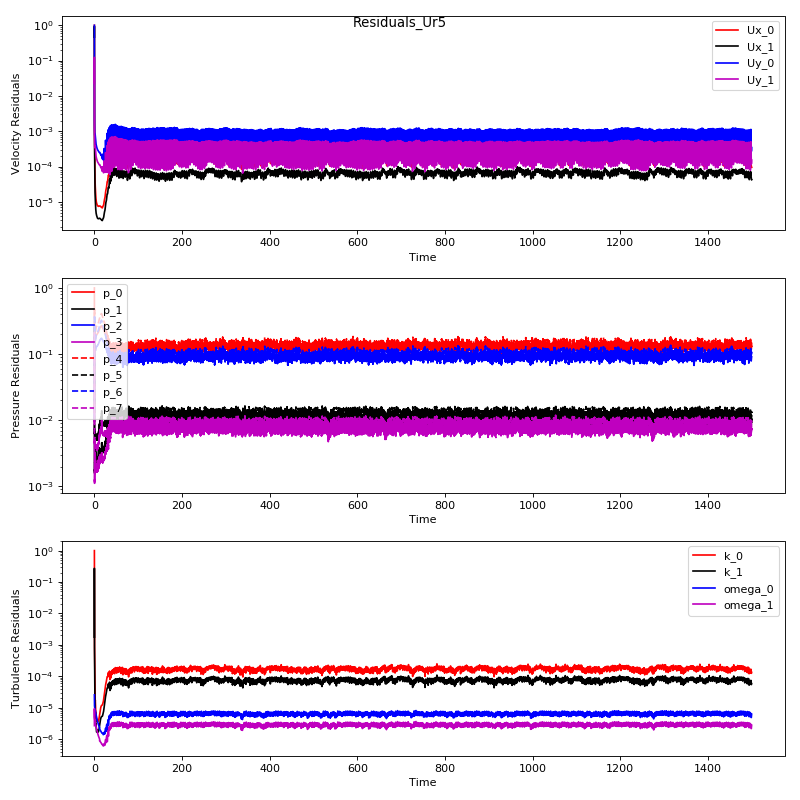
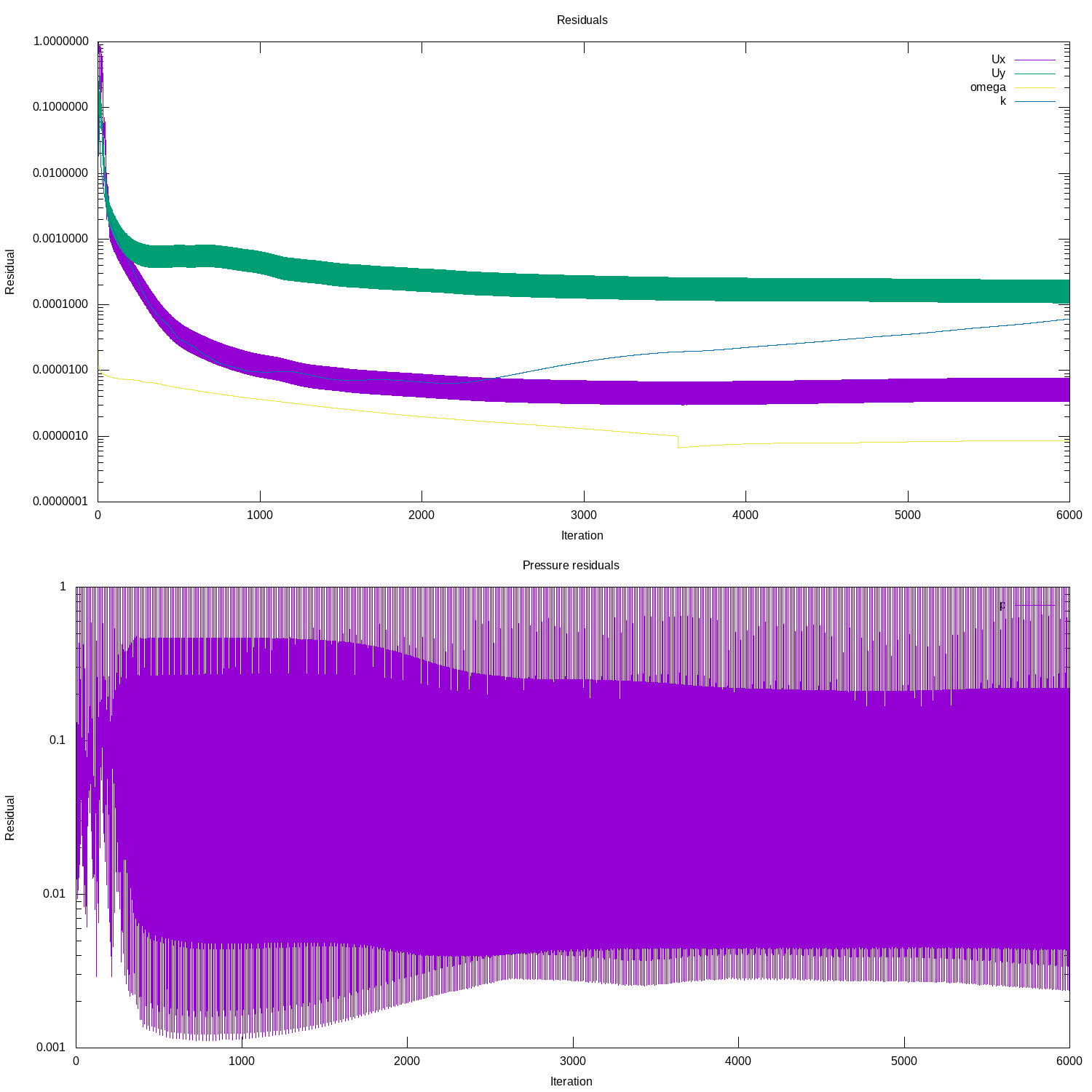 另外,我有一个2D结果湍流统计量k的残差逐渐增大,不太清楚是什么原因造成的,能请各位老师帮忙看下吗?我猜测大概率是PIMPLE算法设置的问题。。。谢谢!
另外,我有一个2D结果湍流统计量k的残差逐渐增大,不太清楚是什么原因造成的,能请各位老师帮忙看下吗?我猜测大概率是PIMPLE算法设置的问题。。。谢谢!





 此时CFLmax=0.7,流场也比较正常,应该是还没来得及崩溃。
此时CFLmax=0.7,流场也比较正常,应该是还没来得及崩溃。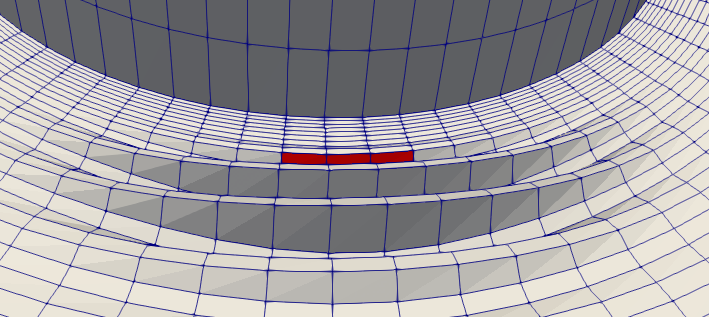
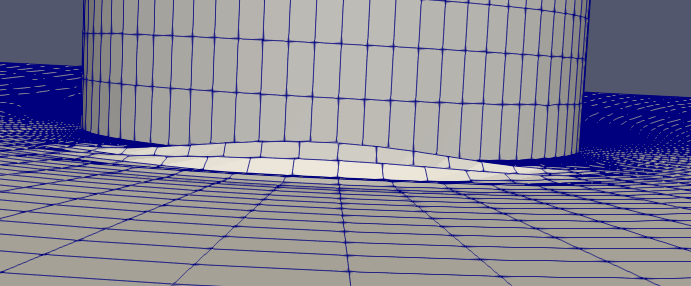 此时圆柱是向+y轴运动,不太明白为什么靠近圆柱(-y轴方向)的这几层网格会凸起。因为这个范围属于设置的inner Distance之内,按理说网格是不变形的,而是直接随圆柱运动。(目前设置是 inner Distance = 1.5m, outer Distance = 2.5m)
此时圆柱是向+y轴运动,不太明白为什么靠近圆柱(-y轴方向)的这几层网格会凸起。因为这个范围属于设置的inner Distance之内,按理说网格是不变形的,而是直接随圆柱运动。(目前设置是 inner Distance = 1.5m, outer Distance = 2.5m)